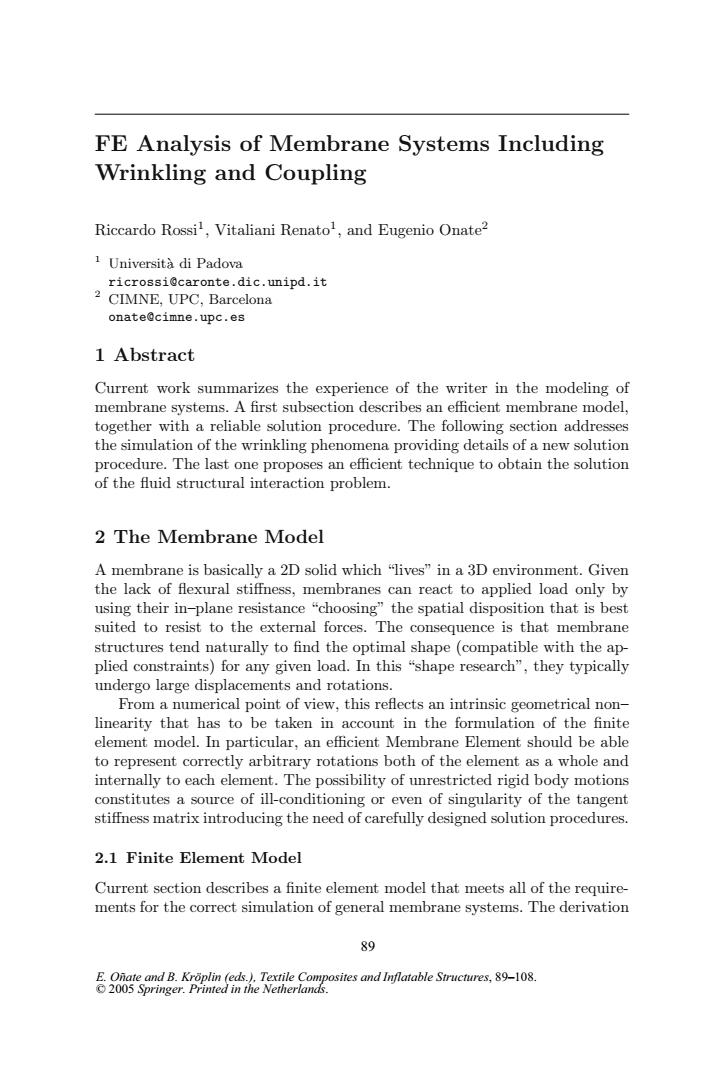正在加载图片...

FE Analysis of Membrane Systems Including Wrinkling and Coupling Riccardo Rossi,Vitaliani Renatol,and Eugenio Onate2 1 Universita di Padova ricrossi@caronte.dic.unipd.it 2 CIMNE,UPC,Barcelona onate cimne.upc.es 1 Abstract Current work summarizes the experience of the writer in the modeling of membrane systems.A first subsection describes an efficient membrane model, together with a reliable solution procedure.The following section addresses the simulation of the wrinkling phenomena providing details of a new solution procedure.The last one proposes an efficient technique to obtain the solution of the fluid structural interaction problem. 2 The Membrane Model A membrane is basically a 2D solid which "lives"in a 3D environment.Given the lack of flexural stiffness,membranes can react to applied load only by using their in-plane resistance "choosing"the spatial disposition that is best suited to resist to the external forces.The consequence is that membrane structures tend naturally to find the optimal shape(compatible with the ap- plied constraints)for any given load.In this "shape research",they typically undergo large displacements and rotations. From a numerical point of view,this reflects an intrinsic geometrical non- linearity that has to be taken in account in the formulation of the finite element model.In particular,an efficient Membrane Element should be able to represent correctly arbitrary rotations both of the element as a whole and internally to each element.The possibility of unrestricted rigid body motions constitutes a source of ill-conditioning or even of singularity of the tangent stiffness matrix introducing the need of carefully designed solution procedures. 2.1 Finite Element Model Current section describes a finite element model that meets all of the require- ments for the correct simulation of general membrane systems.The derivation 89 E.Onate and B.Kroplin (eds.).Textile Composites and Inflatable Structures,89-108. C 2005 Springer.Printed in the Netherlands.FE Analysis of Membrane Systems Including Wrinkling and Coupling Riccardo Rossi 1, Vitaliani Renato1, and Eugenio Onate2 1 Universit`a di Padova ricrossi@caronte.dic.unipd.it 2 CIMNE, UPC, Barcelona onate@cimne.upc.es 1 Abstract Current work summarizes the experience of the writer in the modeling of membrane systems. A first subsection describes an efficient membrane model, together with a reliable solution procedure. The following section addresses the simulation of the wrinkling phenomena providing details of a new solution procedure. The last one proposes an efficient technique to obtain the solution of the fluid structural interaction problem. 2 The Membrane Model A membrane is basically a 2D solid which “lives” in a 3D environment. Given the lack of flexural stiffness, membranes can react to applied load only by using their in–plane resistance “choosing” the spatial disposition that is best suited to resist to the external forces. The consequence is that membrane structures tend naturally to find the optimal shape (compatible with the applied constraints) for any given load. In this “shape research”, they typically undergo large displacements and rotations. From a numerical point of view, this reflects an intrinsic geometrical non– linearity that has to be taken in account in the formulation of the finite element model. In particular, an efficient Membrane Element should be able to represent correctly arbitrary rotations both of the element as a whole and internally to each element. The possibility of unrestricted rigid body motions constitutes a source of ill-conditioning or even of singularity of the tangent stiffness matrix introducing the need of carefully designed solution procedures. 2.1 Finite Element Model Current section describes a finite element model that meets all of the requirements for the correct simulation of general membrane systems. The derivation 89 E. Oñate and B. Kröplin (eds.), Textile Composites and Inflatable Structures, 89–108. © 2005 Springer. Printed in the Netherlands